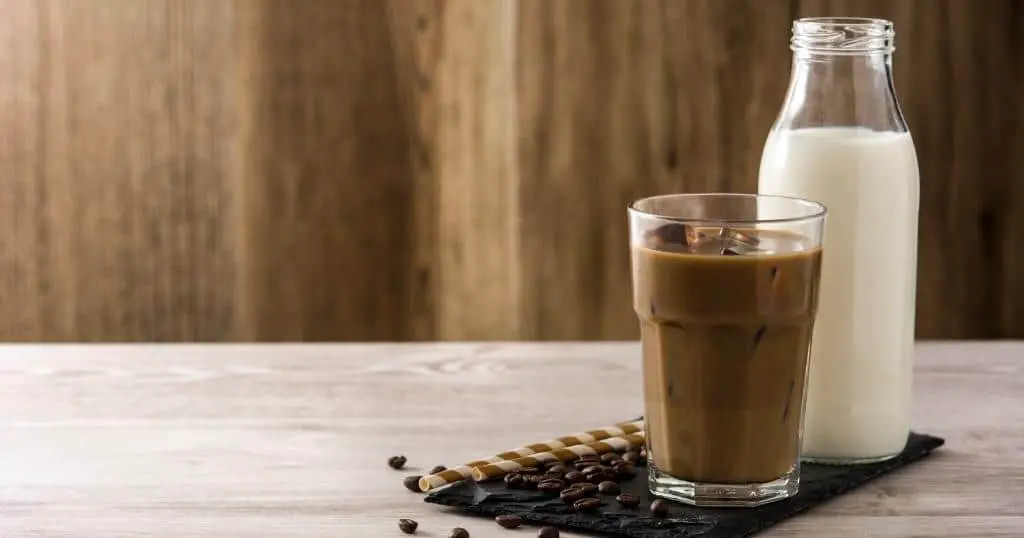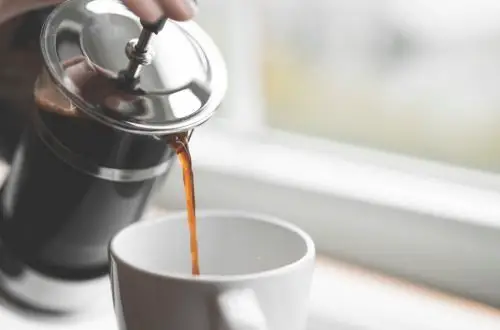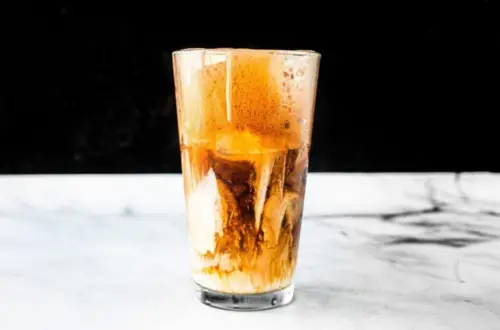What Is An Iced Latte? (& How To Make It!)
When you go to a coffee shop or cafe, there’s a big chance that you’ll see an iced latte on the menu. This espresso drink is loved by so many and once you’ve tried one, you’ll not question its popularity. The combination of bitter coffee balanced by delicate sweetness and creamy, frothed milk is an absolute delight.
An iced latte is a cold coffee based drink made by mixing espresso and milk (sweetener is optional) and served over ice in a tall glass. The iced latte is basically the cold version of a regular latte.
An iced latte leaves you feeling refreshed and gives you a welcome boost of energy, and because the milk offsets the bitterness a fair bit, you don’t need much sugar (or any at all) in a latte even if you’re a sweet tooth – meaning you’re not faced by a sugar crash later in the day.
Have you tried an iced latte? Or if you’ve tried them before and loved them, do you wonder what it takes to make an iced latte at home? Well, you’re about to find out! Give this article a quick read and get ready to start making your own refreshing iced lattes at home.
Contents
- 1 What is an iced latte?
- 2 Iced latte vs iced coffee vs cold brew coffee
- 3 How do you make an iced latte at home?
- 4 How long does an iced coffee last?
- 5 How do you sweeten an iced latte?
- 6 What is the best roast for iced latte?
- 7 What is the best grind for iced latte?
- 8 What are the best beans for iced latte?
- 9 What is the best water to coffee ratio?
- 10 How do you serve an iced latte?
What is an iced latte?
Iced latte is an espresso drink with milk and optional sweetener. Iced latte is, in the simplest form, the cold version of a regular latte. That means it uses two shots of espresso for a medium, milk, and of course some ice. Traditionally, the ice and milk are poured in first, then the espresso shots are added on top – creating a visually striking layered drink.
When you order an iced latte, you will get something very close to a regular hot latte, but not quite the same. The is that some of the elements used in hot latte simply don’t translate well into the iced version. The milk is one of the most obvious differences. Apart from being cold, it’s not frothed or steamed in any way because the foam would have difficulty keeping its structure over ice. However, some baristas will add a dollop of frothed milk on top once the latte is ready to be served.

Iced latte vs iced coffee vs cold brew coffee
If you’re a coffee lover then you must’ve heard of iced coffee, iced latte, and cold brew coffee. All three of them are popular cold coffee drinks. You might be wondering, “what’s the difference?”
Well for a start, all three of them have their own unique taste. Iced coffee has a strong, slightly bitter taste. It’s made by brewing regular, hot coffee and then pouring it over ice. The heating process is what imparts that bitterness.
Cold brew, as you can probably guess, is brewed cold, muting the bitter flavour that comes from the perceived acidity of coffee grounds. Cold brew is made by steeping coffee grounds in cold water for around 12 hours. It’s then up to you whether you add milk.
By definition, iced latte always has milk involved, and as mentioned, is made by pouring recently brewed hot espresso over milk and ice. If you prefer a more balanced taste achieved by a blend of milk and coffee, iced latte is the drink for you. If you’re looking for an even smoother and less acidic taste, then cold brew would be the best option for you.
| Drink | Flavour | Caffeine (usually) |
| Iced latte | Rich and creamy | 126 mg |
| Iced coffee | Medium-bodied and well-balanced | 168 mg |
| Cold brew | Smooth, aromatic, full-bodied | 200 mg |
How do you make an iced latte at home?
Making an iced latte at home is very simple so there’s no need to run to your favourite coffee shop for this one. Instead, save yourself some money and time! All you’re gonna need is 2 espresso shots (60 ml), ice, 100 ml of (preferably) whole milk (or milk alternative), and sugar, maple syrup, or other sweetener to taste.
It only takes a few steps to make an iced latte. First, make your espresso and then mix the hot espresso with your sweetener until it dissolves. Second, fill a glass with ice. Third, add the milk – if you want to, you can froth or shake the milk in a jar but this isn’t mandatory as it doesn’t usually stay frothy for long anyway.
Fourth, pour the espresso shots over the top of milk/ice. Now you can add some frothed milk (or perhaps even whipped cream) on the top if you fancy it. That’s it. That’s how you make an iced latte.

How long does an iced coffee last?
Different factors influence how long your iced coffee can last. If you have a black coffee and store it in an airtight container then it’ll last for 1-2 weeks and still be completely safe to drink (2-3 days is optimal for the best taste, but it’s safe up to 2 weeks). Coffee with milk or creamer will last 2 days in the fridge, but if it stays outside of a refrigerator then it will last no longer than 2 hours.
How do you sweeten an iced latte?
To make your iced latte have a sweeter taste, you’ll (of course) need to add a sweetener such as sugar, syrup, artificial sweetener or honey. The easiest way to add your sweetener is by mixing it with the hot espresso shots prior to mixing all the ingredients together. This way, the sugar or sweetener has a chance to dissolve in the hot liquid espresso.
If you’ve already made your iced latte but take a sip and think it needs a little more sweetness, then you can still add more sweetener. However, if you pour sugar into an iced drink, it will simply fall to the bottom of the glass and won’t dissolve even if you stir it. So, the best thing to do is to boil a shot of water or heat up a shot of milk, then add your sugar or sweetener to it. Then, you add this to your iced latte.
What is the best roast for iced latte?
Coffee beans will give you an indication on the bag of how strong tasting the coffee will be. The best roasts for lattes are medium and dark roasts because these have a medium to full body, slight acidity, and a few strong undertones. Light roast is not really recommended because the notes of a lightly roasted coffee bean can be a bit underwhelming for milky drinks.

What is the best grind for iced latte?
When you make an iced latte, one of the main ingredients is espresso. Ideally, espresso uses a fine grind setting but this can vary between medium-fine to ultra-fine depending on your equipment and which coffee beans you use. But usually, grinds for espresso have a particle size of around 0.8 mm.
Experts say the best-tasting coffee should be ground from whole beans. If you can afford it, buy a pricier burr grinder because it can grind the beans to a more uniform particle size than a blade grinder.
What are the best beans for iced latte?
The coffee bean is an essential part of the latte so ,of course, choosing the right type of bean will make your iced latte taste even better. Below I’ll go over three of my top choice beans for an iced latte.
Sumatra mandheling coffee beans
Sumatra mandheling coffee beans are also known as Indonesian single-origin coffee beans. They have very low acidity making them perfect for espresso and chocolate, roasted chestnut, and caramel flavours that give them a distinct taste. The darker roast level makes for a more punchy iced latte, which is just the way I like them.
Peruvian coffee beans
The best flavour for a latte will be a low acidity with creamy, earthy tones, and a mild body, with chocolate or vanilla undertones. Peruvian coffee beans are perfect for that kind of flavour. Though Peruvian beans are mild-bodied and have a lighter taste compared to some others, they carry the same amount of caffeine.
Brazilian coffee beans
Brazilian dark-roasted coffee beans make the perfect espresso blend. They’re suited for a latte because of their strong, smoky flavour and mild body.

What is the best water to coffee ratio?
The most common water to coffee ratio for espresso that’s used in cafes across the world is 1:2 – that’s one part coffee to two parts water. So, if you start with 20 g of coffee in your basket, you should end up with about 40 g of brewed espresso. But, don’t be afraid to play around with this ratio – you can try anything within the 1:1.5–1:2.5 range (20 g:30 g-20 g:50 g).
How do you serve an iced latte?
Serving your iced latte in an aesthetically pleasing way can enhance the experience. First, choose a clear glass cup of your choice. After you have the cup ready, fill it with ice and milk, and then, pour the sweetened coffee in. The way the coffee and milk layer themselves but gradually begin to mix can be rather beautiful. To make your ice latte even more special, you can add frothed milk to the top, or if you want to feel even more indulgent, whipped cream – yum!
Next, learn what’s the difference between flat white and latte coffee drinks? and check out more brewing guides here!





